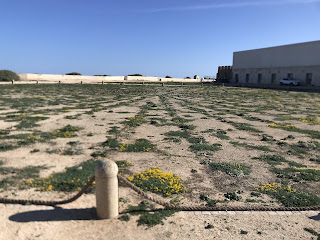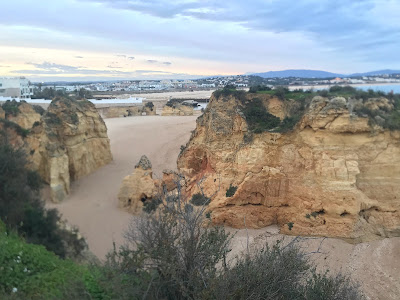We started west along the Algarve coast which serves as a bridge between the Atlantic and the Mediterranean and some of the most beautiful beaches in Europe.
One has to search deeply for the historic centers of these high tourist and expat cities of Albufeira, Portimao, and Lagos (pronounced "La-goosh"). While these have exceptional beaches & marinas, they are as close to high-rise buildings as this area gets. There are several premium golf resorts, fashionable condos and expat "pubs" and cafes. It felt to us to be a spot for a wonderful, leisurely holiday but not authentic Portugal.
 |
| We took an early morning boat tour through the fantastic rock caves and surreal grotto |
Further west we enjoyed the remote and windswept Ponte de Sagres (Cape Sagres) which was called the "Edge Of The World" by the early seafearing explorers. (Seems like we've been to several EOTWs in our travels). On this rugged cliffside Prince Henry the Navigator (1394-1460) established his maritime school that trained generations of sailors to breech the seas where sea serpents roamed and hot equatorial sun melted ships.
 |
| this a huge sun dial or wind rose unearthed in 1921 |
Travel guru, Rick Steves, writes, "While Henry stayed home to update maps, debrief returning sailors, order supplies, and sign paychcks, brave seamen traveled off under Henry’s strict orders not to return until they'd explored what was known as the "Sea of Darkness". Henry ordered scared, superstitious sailors to press on. After 14 unsuccessful voyages, Gil Eanes' crew returned (1437), unharmed, with new knowledge that was added to corporate Portugal's map library." (Rick Steves Portugal, 2021)
After Henry's death and for several generations, infamous captains during the Age of Discovery built ships and studied astronomy, botany, mathematics and languages at the maritime school to launch further expeditions. It's said that Bartolomeu Dias (1488 rounded Africa), Vasco da Gama (1497 found sea route to India), Pedro Cabral (1500 discovered Brazil), Ferdinand Magellan crew (1519 circumnavidator), and even a young Christopher Columbus all studied at the school.
Today there is virtually nothing left but some stones in the ground to signify the greatness that occured there. Later an 18th century fortress was built on the site and today we are able to walk on a path along the edge of the cliffs. At the very end of the bluff we saw a man who was fishing! He was packing up when we arrived but we did see his very long rod and looked back at the 150 foot sheer drop.
Turning the corner to head north, we began to make our way up along the the Atlantic coast. Here the seas experience high waves and every little cove that has stories of pirates and looting Moors, now seem to be enclaves for surfers. While the waves were not big when we visited we did see some hearty souls in wetsuits. These are not expansive surf beaches like California or Hawaii but small coves that surfers must manuver into between the rocks ledges.
Outside of the town of Aljezur in the hills we were stopped by an older woman waving a stick. As we slowed we realized their 2 dozen cattle were crossing the road. They were very hefty guys and the leads had loud bells.
We have also passed several mule-drawn carts on the roadways which are still used by farmers or gypsies/Roma people
Our final night was at a small roadside hotel/inn that was so traditionally Portuguese. It had a restaurant and bar that was the only one in the small "don't-blink-or-you'll-miss-it" village. The bar had spot for about 4 people at the counter and another two tables and always had customers!
 |
| Great local cuisine and a huge collection of wine |
 |
| One of the regular customers |
This is cork oak tree country and we saw lots of the trees that had been harvested. I talked to a farmer (in my very limited Portuguese) and he told me the trees can be harvested every 10 years.
 |
| Cork trees & the harvesting is highly regulated |
 |
| The trees are marked with the year it was harvested |
 |
| The cork bark is very light weight but it takes three harvests to be fine enough to be made into Wine corks |
 |
| We came across an abandoned orchard that was full of hundreds of storks in nests |
 |
| The only sound that storks make is a very loud clacking of their beaks that may be for communication |
We sold our ebikes before we came to Portugal and really were missing them. We luckily found two used folding bikes that we can take on the train to see more of our countryside.
 |
| Folded in the bike compartment on the train |
 |
| Paved and dirt bike path run the length of the Algarve (150 miles) and we hope to ride it all…in segments! |













No comments:
Post a Comment